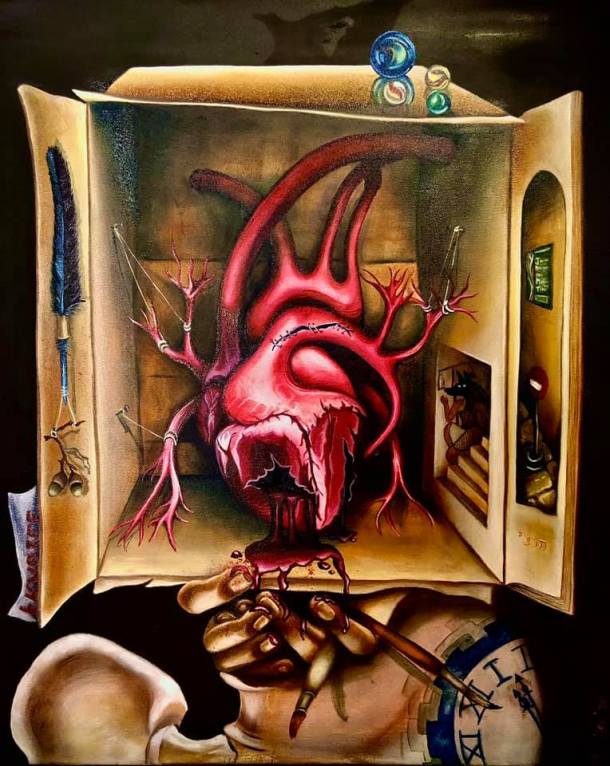
This highly symbolic work of Sasha Chaitow, reflects upon the human condition
THE DIVIDE between artists who still use traditional artistic mediums and those in favour of a more conceptual art, has created two different camps in the art world of today, even in Greece. The former are considered more as craftsmen, criticized for being ‘stuckist’, and bogged down with capturing light effects, creating illusions of reality, mastering painting and sculptural techniques, whilst the latter are considered more high-brow, political, philosophical, intellectual. Yet also insular, seeing as they are mainly understood by those who have a deep knowledge of art and its historical movements, and who are willing to do their reading in order to understand their artistic profundity, thus excluding the major part of the public, and creating an art for elite circles. However, one could argue that there is still scope for more philosophical quests and symbolic quests too, in the more traditional forms of art, such as painting and sculpture. This is exactly what the exhibition ‘New Symbols’, at the Chili art gallery, presents: how symbolism in painting and sculpture of today can pose questions too, and focus on modern day issues in probing ways, rather than just paint a pretty picture.
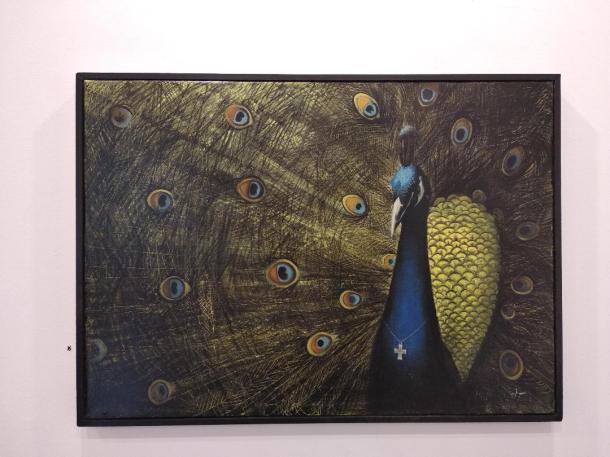
The peacock was a popular symbol in the movements of Decadence and Art Nouveau. It now reappears as a symbol in the work of Fanis Goulis
In order to understand this ‘new symbolism’, we need to first look at where its roots lie: Symbolism was a movement of reactionary idealism, evident especially in the literary world, in the work of Baudelaire, Mallarme, Poe, Rimbaud and Wilde. Many cite its origins in France, in the 1880s, while it developed further in the 1890s, spreading throughout Europe and America. It was primarily a reaction against the positivist, scientific age of the times. Idealistic in spirit, Symbolism was closely related to the movements of Decadence and Art Nouveau, and was a kind of continuation of 18th century Romanticism, whilst preferring to reject Naturalism. One could say that Symbolism also paved the way for the movements of Expressionism and Surrealism, and many would argue that conceptual art is its later manifestation. However conceptual art has stripped art’s creative process of its more traditional mediums and aesthetic preoccupations, in search of more philosophical, semantic quests which have often brought objects from the real world into its realm, and has made the fine line between art and life so fine, that sometimes it’s hard to distinguish which is which. (Of course often times this is also its beauty).
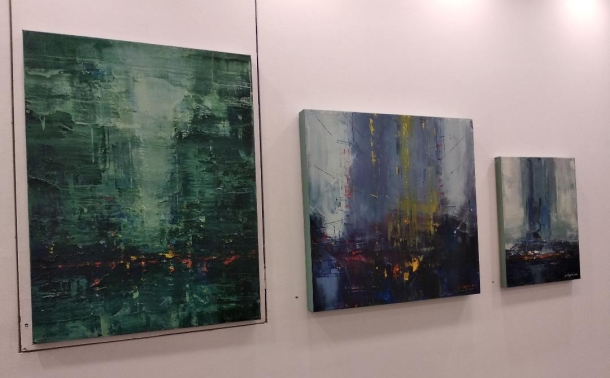
Foti Kllogjeri’s abstract cityscapes
Symbolism was also a movement that looked within, towards the human soul and psyche, the dream, but also towards the spiritual, the metaphysical, and the mysterious. It searched for symbols both in its own epoch, but also in those of the past.
Curated by Paris Kapralos and Iason Kaerofyllas, the exhibition ‘New Symbols’ focuses therefore on a group of artists that have tackled their subject-matter in a symbolic manner, creating allegories or symbols out of everyday objects and scenes. They have been attracted to certain subjects for their symbolic worth, as well as their formal/artistic properties. The participating artists are members of the recently formed ARC (Art Revisited Collective): Angeliki Kourmoulaki, Konstantinos Mennis, Foti Kllogjeri, Christina Zigouri and Stergios Goudinis, together with likeminded guest artists Elena Stratidakis, Ennio Eros Giogos, Stella Sevastopoulos, Rania Anasotzi, Alexandros Kantoros, Konstantina Mina, Fanis Goulis, Ourania Karolina Koliopoulou, Foti Kllogjeri, Alexia Koudigkeli, Maria Stratidaki, Sasha Chaitow, Tita Stavrou.

‘Nemesis’ by Maria Stratidakis
Highlights of ‘New Symbols’
In the work ‘Nemesis’, Maria Stratidakis explores the symbol of the human figure, sometimes depicting it as a cross, and sometimes as a dark angel. A triangular form can also be perceived in the centre of the work. The abstract cityscape becomes a symbol of our times for artist Foti Kllogjeri, while Tita Stavrou explores the connections between chess and life in her work ‘Virtual Game’.
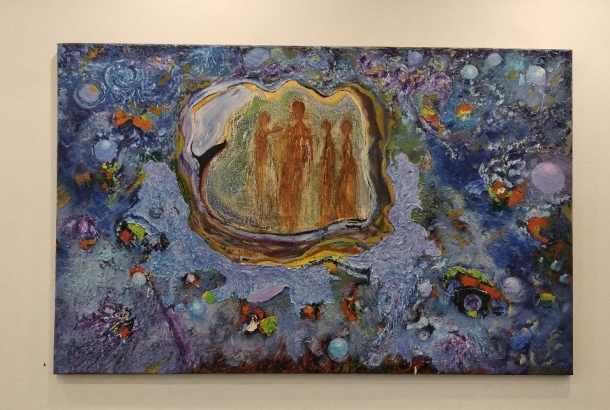
‘The Immortality of the Bubble’, by Konstantinos Mennis
The exploration of dream images or the concept of the dream are explored by Konstantinos (or Kostas) Mennis and Konstantina Mina, in very different ways: the former presents us with a dream-like vision of a family of humans trapped in a bubble-like form in the work ‘The Immortality of the Bubble’, while the latter plays with the notion of the ‘Dreamcatcher’, via abstract experimentations with paint pouring techniques. “There might be a catch to every dream come true, or a dream can emerge from a catch” explains Mina, who worked as an economist, before she turned to art. Dream, mystery, spiritualism are explored by Angeliki Kourmoulaki in the works ‘Veritas’ and ‘Spiritalitas’, while birds take on symbolic meanings in the works of Sasha Chaitow and Fanis Goulis.
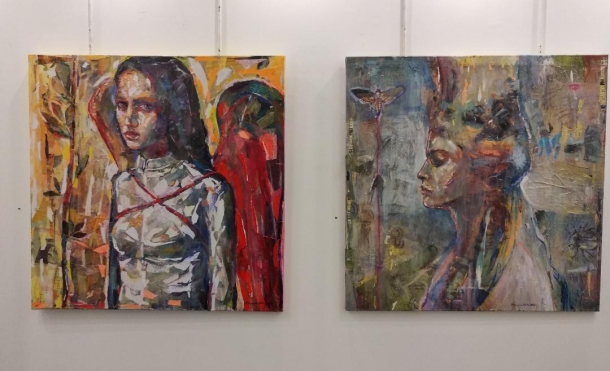
‘Veritas’ and ‘Spiritalitas’, by Angeliki Kourmoulaki
Antiquity’s ancient fluted columns are juxtaposed with clotheslines decked in all sorts of drying attire, in the works ‘Laundry’ and ‘Wrath of the Gods’, by Maria Stratidakis. These works might well have been inspired by some scenes spotted in certain areas of Greece where refugees had been camping near ancient ruins, but these images also symbolize the modern trend towards the devaluation, or even de-mythification of our cultural heritage, in favour of progress and the new.
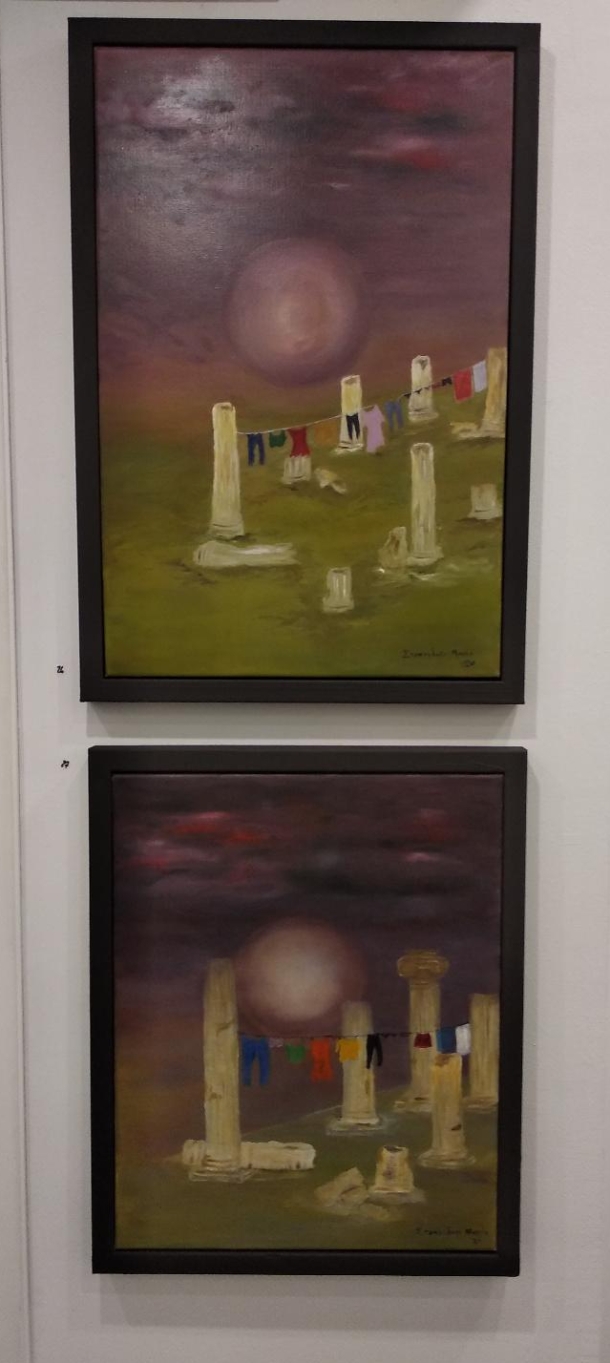
‘Laundry’ and ‘Wrath of the Gods’, by Maria Stratidakis
Artists have drawn from nature’s world to create symbols from the beginning of human civilization, so why not also in today’s world, where the natural environment is being threatened by man, making the relationship between man and nature something of an issue that needs to be re-examined. For Karolina Koliopoulou (who apart from painting, is also a gynecologist), the natural scenes that she has depicted symbolize special moments in time, from her own travels and holidays, while Elena Stratidakis’ work ‘For Sale’ depicts an aerial view of a plot of land in the Brazilian rain forest, upon which she has also added a bar code. The message of this work is crystal clear and very effective. I (Stella Sevastopoulos), on the other hand, have sought out the symbolism in natural scenes: for example ‘Into the Light’ was created during the lockdown, and depicts a tunnel of trees from which we emerge into the light, while ‘The Path Less Trodden’, symbolizes the alternative, quieter, less mainstream routes that one can take in life.
Although photography is usually associated with the capturing of the moment, and of reality, the photographs of Alexandros Kantoros have taken this medium into much more mysterious realms, while the oil paintings of the left hemisphere of the brain, and a pork chop, by Stratidakis bring us right back to the here and now, and the ‘meat market’ of today’s cut-throat world. And there’s lots more to explore in this exhibition, such as Christina Zigouri’s ‘Don’t Look Back, the Way is Forward’, Alexia Koudigkeli’s ‘Phoenix’, Ennio Eros Giogos’ intriguing ‘Broken Scripture’ and Stergios Goudinis’ immaculate sculptural forms. The 46 works that make up this exhibition prove that symbolism in art is very much alive, and something that can be explored on a personal level, or in a much wider context, connecting with contemporary issues in the process.
• Runs till July 18 at the Chili Art Gallery (13-15 Dimofontos Street, Thission).

‘Into the Light’ and ‘The Path Less Trodden’, by Stella Sevastopoulos